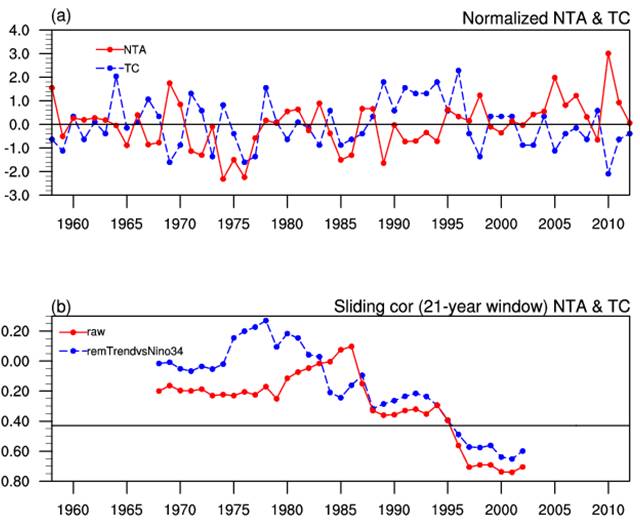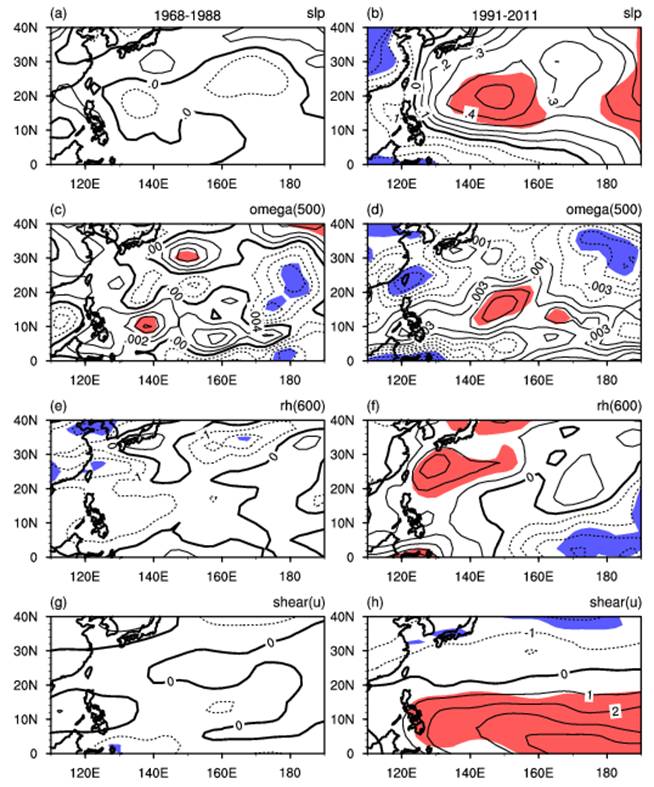Intensified impact of northern tropical Atlantic SST on western North Pacific tropical cyclones
Date:2016-02-22
Tropical cyclones (TCs) are one of the most severe natural disaster types in the world. They can have substantial impacts on the economy, industry, agriculture, and people’s daily lives. Every year, about seven or eight TCs make landfall in China, and sometimes as many as twelve. Thus, a better understanding of TC variability and its factors of influence, as well as improved predictability of TC activity, are of great importance to society.
Previous studies have shown that the frequency of summer TCs over the tropical western North Pacific (WNP) correlates negatively with the preceding spring SST of the northern tropical Atlantic (NTA) via modulation of the atmospheric circulation. In work recently accepted for publication in Advances in Atmospheric Sciences (Cao et al., 2016), researchers from the Institute of Atmospheric Physics examined the relationship between the SST of the NTA in spring and the following summer’s TC formation frequency over the tropical WNP, and found it experienced a pronounced interdecadal shift around the late 1980s (Fig. 1). The relationship becomes strong and statistically significant after the late 1980s.

Fig. 1. (a) Normalized time series of the original spring (March–May, MAM) NTA SST index (red solid line) and the original following-JJASON (June–November) TC genesis frequency index derived from the JTWC (blue dashed line) over the WNP. (b) The red solid line denotes the sliding correlations between the original MAM NTA SST index and the original following-JJASON WNP TC genesis frequency index displayed at the center year of a 21-yr window. The blue dashed line in (b) is the same as the red solid line but the long-term trend and preceding winter ENSO signal have been removed from the MAM NTA SST index and JJASON WNP TC genesis frequency index. The horizontal black line in (b) indicates the correlation coefficient is significantly different from zero at the 5% level. (Figure plotted by Cao et al.)
Their results indicate that the SST of the NTA in spring led to a La Ni?a–like SST anomaly, lower-level anomalous anticyclonic circulation, upper-level anomalous cyclonic circulation, enhanced descending motion, and a negative mid-level relative humidity anomaly in the tropical western–central Pacific during 1991–2011, whereas the anomalies of the above quantities induced by the SST of the NTA in spring were weak before the late 1980s (Fig. 2). Hence, large-scale dynamic and thermodynamic anomalies were more favorable for TC formation over the eastern WNP after the late 1980s.

Fig. 2. Anomalies of the following-summer (a, b) SLP, (c, d) vertical velocity at 500 hPa, (e, f) relative humidity at 600 hPa and (g, h) vertical zonal wind shear between 200 hPa and 850 hPa obtained as regressions upon the normalized spring NTA SST index in (a, c, e, g) 1968–1988 and (b, d, f, h) 1991–2011. Contour intervals are 0.1 hPa in (a, b), 0.002 Pa s?1 in (c, d), 1% in (e, f), and 1 m s?1 in (g, h). (Figure plotted by Cao et al.)
The analysis described in this paper further shows that the intensified impact of NTA SST on western North Pacific TC activity is closely related to changes in the spring climatological SST over the NTA. The results obtained in this study may potentially help to improve the predictability of summer TCs over the tropical WNP.
Reference
Cao, X., S. Chen, G. Chen, and R. Wu, 2016: Intensified impact of northern tropical Atlantic SST on tropical cyclogenesis frequency over the western North Pacific after the late 1980s. Adv. Atmos. Sci., doi: 10.1007/s00376-016-5206-z.
Contact: Dr. CHEN Shangfeng, chenshangfeng@mail.iap.ac.cn
